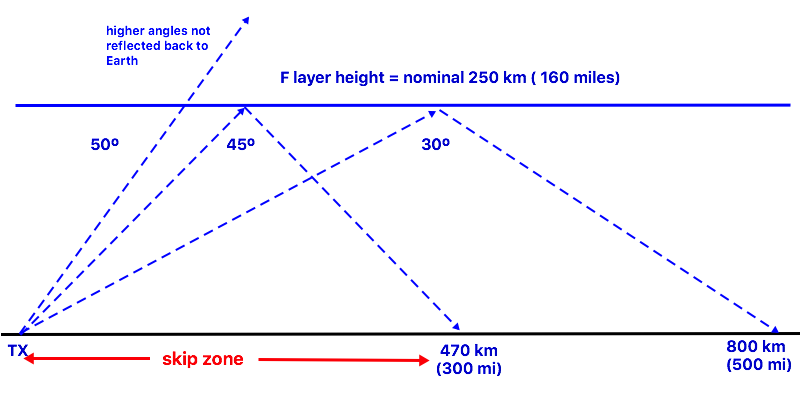A Beginner’s Guide to NVIS
last updated 26 March 2023.
OK, I admit that sometimes I can get carried away with details in my articles, making them rather intense for those who aren’t already conversant with the material. So I’m adding some of these Beginner pages to provide context and overview for those who aren’t ready for the main articles. Sometimes this may be sufficient by itself, other times it hopefully will give you an introduction to help understand the following material.
why do we care about NVIS?
HF propagation via the ionosphere is quirky. On the popular bands that provide longer distance contacts, like 20m, we often can’t contact stations at distances closer than about 1000 km (600 miles). What do we do when we want to have relatively local coverage, perhaps within 100 km to 200 km (60 to 120 miles)?
Hams have used 40m and 80m for local contacts for decades before this mode was given a fancy name (“Near-Vertical Incident Skywave”, or “NVIS”) and popularized for the military in the 1960s. To understand the capabilities and limitations, we need to briefly discuss how ionospheric propagation works.
For many signals the ionosphere acts like a mirror, reflecting signals back to Earth and enabling communications at long distances. But sometimes it doesn’t. Imagine looking at a lake – you often see the reflection of the surrounding mountains when you look at an angle. But if you look straight down into the water, you can see rocks and fish rather than a reflection. In this case, the angle at which you look into the water determines whether or not you see the reflection.
The ionosphere is similar: at low angles, radio waves reflect off of the ionosphere. But when they arrive at too steep of an angle, they pass through it and off into space rather than reflecting.

We end up with a situation as shown in Figure 1, where the ionosphere doesn’t reflect waves at high angles, resulting in a “skip zone” where we can’t make contacts.
The conditions of the ionosphere depend on many factors, including the time of day, time of year, current sunspot activity, latitude, and, of particular interest in this case, the frequency of operation. Lower frequencies will reflect at higher angles, allowing coverage of shorter distances. At some point, at a low enough frequency, the ionosphere will reflect vertical radiation straight back down, so there is no “skip zone”. We call that the “critical frequency“.
When we use a band below the critical frequency, we can send our signals straight up (or nearly so), and have them reflected back to Earth at short distances, providing good local coverage. Because the signal is bouncing off the ionosphere and back down, we can talk to stations on the other side of a mountain: signals are going over it rather than through it. This provides reliable communications to a distance of 300 km (200 miles) or more.
Except, of course, when it doesn’t…
One of the biggest issues is that the critical frequency is always changing. If you are too far below it, then absorption can be high and signal strengths weak. If it drops below the frequency you are using, signals drop out. Often we may need to use 2 or even 3 different ham bands to maintain a particular path over a 24 hour period.
If you plan to use NVIS, make sure you have antennas for the different bands you may need to use. Generally the critical frequency may get as high as 12 MHz or so in the tropics, and perhaps 9 MHz at higher latitudes. It is generally highest in the afternoon, and drops around dusk. During winter at the bottom of the sunspot cycle it tends to be lowest, and highest in summer at the sunspot peaks. So we are generally going to use the 40m, 60m (where available), 80m, and 160m bands.
A common convention is to use 40m during the day, and 80m at night. Here at 45º North latitude, we often need to use 80m during the day and 160m at night when sunspot counts are low. The important thing to remember is that you need to pick the right band for the current conditions, rather than just using what is convenient and hoping it will work.
How do you know if you are on the right band? If you can’t hear anything, try a higher frequency band. If you can hear distant stations but not closer ones, try a lower band.
Antennas that aim your signal straight up are actually pretty simple: a horizontal wire like a simple half-wave dipole will provide the desired pattern as long as it isn’t too high (less than 1/3 wavelength or so). Very low heights can work, with some loss of signal strength. But when the band is open, signal strengths should be good, and even an antenna 1 m (3 feet) off the ground can work.